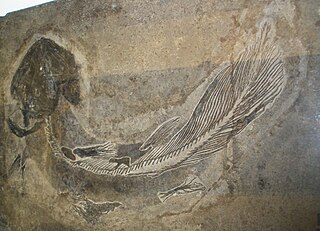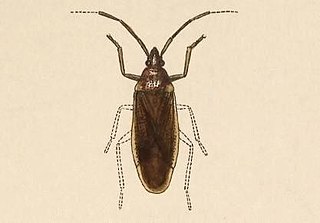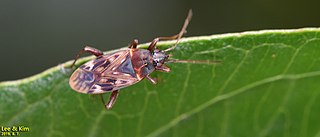
Woodwardia is a genus of ferns in the family Blechnaceae, in the suborder Aspleniineae of the order Polypodiales. Species are known as chain ferns. The genus is native to warm temperate and subtropical regions of the Northern Hemisphere. They are large ferns, with fronds growing to 50–300 cm long depending on the species. The fossil record of the genus extends to the Paleocene.

Palaemonidae is a family of shrimp in the order Decapoda. Many species are carnivores that eat small invertebrates, and can be found in any aquatic habitat except the deep sea. One significant genus is Macrobrachium, which contains commercially fished species. Others inhabit coral reefs, where they associate with certain invertebrates, such as sponges, cnidarians, mollusks, and echinoderms, as cleaner shrimps, parasites, or commensals. They generally feed on detritus, though some are carnivores and hunt tiny animals.

Coelacanthus is a genus of extinct coelacanths that first appeared during the Permian period. It was the first genus of coelacanths described, about a century before the discovery of the extant coelacanth Latimeria. The order Coelacanthiformes is named after it.

Eopsaltria is a genus of small forest passerines known in Australia as the yellow robins. They belong to the Australasian robin family Petroicidae. The name is derived from the Ancient Greek for "dawn singer/song" because of their dawn chorus. They are inquisitive and bold birds, and have been reported perching on the shoulders or boots of people in the bush. Open eucalyptus woodlands are their preferred habitat. The ornithologist John Gould likened the behaviour and mannerisms of the eastern and western yellow robin to those of the European robin. The name "yellow robin" itself was applied to the eastern yellow robin by the early settlers of New South Wales.

Mesostigmata is an order of mites belonging to the Parasitiformes. They are by far the largest group of Parasitiformes, with over 8,000 species in 130 families. Mesostigmata includes parasitic as well as free-living and predatory forms. They can be recognized by the single pair of spiracles positioned laterally on the body.

The Palaeonisciformes, commonly known as "palaeoniscoids" are an extinct grouping of primitive ray-finned fish (Actinopterygii), spanning from the Silurian/Devonian to the Cretaceous. They are generally considered paraphyletic, but their exact relationships to living ray-finned fish are uncertain. While some and perhaps most palaeoniscoids likely belong to the stem-group of Actinopteryii, it has been suggested that some may belong to the crown group, with some of these possibly related to Cladistia and/or Chondrostei. Many palaeoniscoids share a conservative body shape and a similar arrangement of skull bones.

Acrolepis is an extinct genus of prehistoric bony fish that lived from the Tournaisian stage of the Mississippian to the late Permian epoch. Some species from the Early Triassic of Tasmania are also ascribed to Acrolepis.

Palaeoniscidae is an extinct family of "palaeoniscoid" ray-finned fishes (Actinopterygii).. The family includes the genus Palaeoniscum and potentially other Palaeozoic and Mesozoic early actinopterygian genera. The name is derived from the Ancient Greek words παλαιός and ὀνίσκος.

Ptycholepiformes are an extinct order of prehistoric ray-finned fish that existed during the Triassic period and the Early Jurassic epoch. The order includes the genera Acrorhabdus, Ardoreosomus, Boreosomus, Chungkingichthys, Ptycholepis, and Yuchoulepis. Although several families have been proposed, some studies place all these genera in the same family, Ptycholepididae.

Acrolepididae is an extinct family of ray-finned fish. Genera referred to Acrolepididae existed from the Early Carboniferous period to the Early Triassic epoch. They were nektonic carnivores with a fusiform body.

The Blissidae are a family in the Hemiptera, comprising nearly 50 genera and 400 species. The group has often been treated as a subfamily of the Lygaeidae but was resurrected as a full family by Thomas Henry (1997).

Ozophorini is a tribe of dirt-colored seed bugs in the family Rhyparochromidae. There are more than 30 genera and 220 described species in Ozophorini.
Labops is a genus of plant bugs in the family Miridae. There are about 13 described species in Labops.

Lethaeini is a tribe of dirt-colored seed bugs in the family Rhyparochromidae. There are more than 40 genera and 180 described species in Lethaeini.

Artheneidae is a family of true bugs in the order Hemiptera. It was formerly included in Lygaeidae. There are about 7 genera and at least 20 described species in Artheneidae.

Antillocorini is a tribe of dirt-colored seed bugs in the family Rhyparochromidae. There are more than 30 genera and 110 described species in Antillocorini.

This timeline of eurypterid research is a chronologically ordered list of important fossil discoveries, controversies of interpretation, and taxonomic revisions of eurypterids, a group of extinct aquatic arthropods closely related to modern arachnids and horseshoe crabs that lived during the Paleozoic Era.

Neolethaeus is a genus of dirt-colored seed bugs in the family Rhyparochromidae. There are more than 20 described species in Neolethaeus, found mainly in Asia, Australia, and Africa.
















